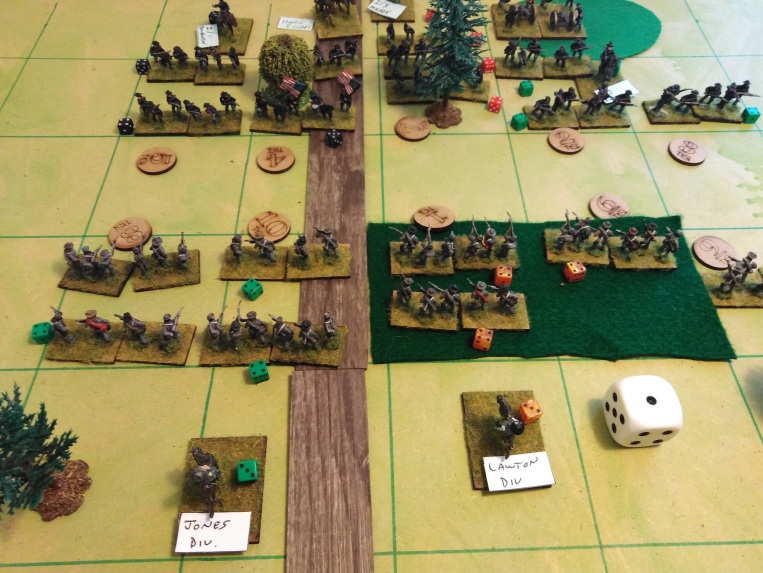I thought I would try out the Portable Napoleonic Wargame rules by Bob Cordery for the American Civil War.
The scenario was loosely based on the early morning assault at Antietam by Hooker’s Union First Corps on Confederate General Jackson’s Corps, which formed the left wing of Lee’s army. This was the part of the battle that featured the very bloody fight over Miller’s cornfield.
Although this was a Corps level battle, I used the Division level rules from Bob’s book – the book having rules for Brigade, Division and Corps level games.
Each side had 10 brigades spread across three Divisions. On the Union side, there were the Divisons of Doubleday, Meade and Ricketts. On the Confederate side, the Division Commanders were Lawton, Hood and Jones.
All Brigades were average apart from one elite Brigade (5SP) in each army – Hood’s Texans and the Iron Brigade in Doubleday’s Division.
As far as the rule changes were concerned, the key ones were:
- The activation system involved having X counters, each with a different number from 1-X with X being 1/2 of all the units on the table. Each side could place a number of counters face down, equal to half the number of units it had on the table at the time. The counters were then turned over and that was the order in which the units were activated. Units could save their activation for firing later in the turn if they wished.
- There was no separate artillery phase – they were activated like other units.
- Rifled artillery had a longer range than smoothbore but was less effective at closer range to take into account smoothbore grapeshot.
- I scaled the grids at about 300 yards – about the same frontage as a typical 900 strong brigade. Each brigade had two bases and I allowed two brigades in a grid.
- I have read that troops were rather lessing willing to charge or stand a charge in the ACW. To take this into account and introduce a bit of the to and fro action, units had to throw less than or equal to their SP (strength point) to charge in and likewise to stand if the enemy was charging them with a bonus if a commander was present. If they failed to charge or stand, they could fire instead but at -1. Failing to stand meant the unit had to retreat.
- I limited musket and rifle fire to one grid. With all the smoke around, I am not sure that rifled muskets were shooting effectively at much more than a couple of hundred yards anyway!
- If attacking, brigades got a +1 if there was a brigade lined up behind them and in the same grid. This is meant to represent wave attaks but I am not sure about this!
- Although not relevant to this scenario, I treat cavalry as more or less mounted infantry and took out any references to forming squares and all that milarkey! (Although I did recently discover that, apparently, squares were very occasionally formed, but this, like cavalry charges, was very rare).
All in all, the changes seemed to work well in a brief solo game, with the bloody attacks over the cornfield being well replicated.
Here are a few pictures of the game:

Here is the initial deployment from behind the Confederate lines and looking North. Dunker Church is in the foregrouns and the green felt is the cornfield.




A fun little experiment that I will try again. The Portable system can cope well with being played around with and, I believe, can also be good for historical scenarios.
Nice post Simon, great pictures!
LikeLike
Cheers Sean
LikeLike
Interesting to see other people experimenting with the Portable Napoleonic Wargame for the ACW. I’ve been using Bob’s card activation mechanisms from the book, requiring artillery firing to be one of the activations. I have made rifles longer ranged than smoothbore muskets because I have seen enough accounts of battles noticing that effect (for instance the early battles in the 1862 Shenandoah campaign) where rifle armed infantry had a clear range advantage.
LikeLike
Hi Dave and thanks for your interest in the blog. On the subject of rifled musket ranges, I felt that as I was working on around 300 yards to a grid, giving a rifled musket a range of 600 yards seemed a bit high. I also found Guelzo’s arguments on the subject persuasive.
Cheers,
Simon
LikeLike
Bit late seeing this but hey! That’s the Internet. I found this post, and the comments very helpful. I’m putting together two ACW armies using 20mm Jacklex figures and I had decided to adapt Bob’s Napoleonic rules (at his suggestion). He has recently said he wants to write a specific set of PW ACW rules so any ACW game experience gained by players would probably be gratefully received.
LikeLike